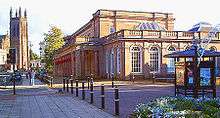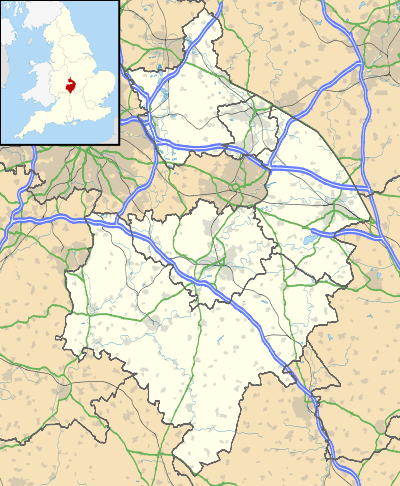Royal Pump Rooms
The Royal Pump Rooms is a cultural centre on the Parade in Leamington Spa, Warwickshire, England. It was the most famous of several spa baths opened in Leamington between the late-18th and mid-19th centuries. People would travel from throughout the country, and indeed Europe, to benefit from treatments using the town's healing waters. When 'taking the waters' became less fashionable after the mid-19th century the Pump Rooms became Leamington's only surviving spa facility, later also being extended to include the town's public swimming pool. After a major redevelopment in 1997-99 the building now houses Leamington Spa Art Gallery & Museum, a public library, a Tourist Information Centre, cafe and assembly rooms. It is a Grade II listed building.[1]
| Royal Pump Rooms | |
|---|---|
 Royal Pump Rooms | |
| Location | The Parade, Leamington Spa |
| Coordinates | 52.2869°N 1.5344°W |
| Built | 1814 |
| Architect | Charles S. Smith |
| Architectural style(s) | Classical style |
Listed Building – Grade II | |
| Designated | 1 March 1949 |
| Reference no. | 1381439 |
 Shown in Warwickshire | |
History
Background and beginnings
By the time that a spring had been found at the site of the rooms in 1811 Leamington already had a reputation as an up-and-coming spa resort. Six wells had been discovered south of the River Leam in and around the village.[2] The influx of tourists to bathe in these springs and 'take the waters' had led to speculators developing land to the north of the river. It was decided by these men that they needed to find a spring on their side of the river so that they could erect a suitably grand building to match the town they aimed to develop. Another spring was found in 1811 on the land of Mr Bertie Greatheed[3] and the architectural work was undertaken by local man Charles S. Smith (who also designed The Regent Hotel and the Upper Assembly Rooms in the town) in the Classical style.[1] The building named The New Pump Rooms and Baths was opened three years later in July 1814.[1]
Within months of opening however the baths proved so popular that the building needed to be extended. The building was finally complete two years later in 1816. Including the wings at the north and south end the building was 166 feet long with 17 hot baths and 3 cold baths. The total development cost was a fraction under £18,000. One of the most interesting, although not at the time most famous or notable, parts of the development were the pumps which were manufactured by the engineering giants Boulton and Watt of Smethwick, Birmingham. It also included the world's first gravity fed piped hot water system in modern times, which was designed and installed in 1815 by the engineer William Murdoch.[4]
Hard times
From the 1840s onwards the British spa town tourist industry began to wane thanks to the growing popularity of spas in continental Europe, notably Belgium and France. Faced with the decline in demand for spa health treatments the decision was made in 1860 to close the Pump Rooms with a view to demolishing them and selling the land. However a group of local investors clubbed together and bought the building in October 1861. After spending £17,000 refurbishing the building, including adding a Turkish Bath and swimming pool, the Pump Rooms re-opened in 1863.[5]
However, it proved impossible to operate at a profit and it was sold to the Local Board of Health in 1868.[5] Since that time the building has remained in the public sector and in 1875 the Royal Pump Room Gardens next to the building were opened to the public under the management of George Elson.[5] In 1889 a further large public swimming pool was opened.[5] An annexe was added to the south of the main assembly room in 1910 and another to the north some years later. Around 1950 the tower added in the 1860s was demolished. In 1989 the swimming pool was closed and relocated to a new leisure centre building in Newbold Comyn.[6]
Redevelopment
After a number of different schemes to redevelop the Royal Pump Rooms had been considered, in 1997 work began on a major project to reuse it as a cultural complex. This opened after two years of redevelopment led by Warwick District Council in partnership with Warwickshire County Council, South Warwickshire Tourism Ltd and a catering company. The Leamington public library and public art gallery were relocated here from their former "Old Library" and annexe site on Avenue Road. The main swimming hall was used to house the library, the smaller swimming hall and Turkish Baths converted to house Leamington Spa Art Gallery & Museum.[6]
Popular culture
During the dormant 1990s period the video for the Mick Jagger song "Sweet Thing" was filmed in the baths.[7]
See also
References
- Historic England. "Royal Pump Room and Baths (1381439)". National Heritage List for England. Retrieved 6 May 2014.
- Salzman, L F (1951). "'The borough of Leamington Spa', in A History of the County of Warwick: Volume 6, Knightlow Hundred". London: British History Online. pp. 155–161. Retrieved 31 July 2020.
- Layton, Josh (20 June 2020). "Calls for Cov and Warwickshire to face up to hidden slave trade links". coventrytelegraph. Retrieved 27 June 2020.
- "Is Royal Leamington Spa the happiest place in the UK?". Financial Times. 23 March 2018. Retrieved 31 July 2020.
- "Royal Leamington Spa: Royal Pump Rooms and Baths". Victorian Turkish Bath. Retrieved 31 July 2020.
- "Closure Notice". Windows on Warwickshire. Retrieved 31 July 2020.
- "Pump up the volume and stir up the spa". The Independent. 20 January 1993. Retrieved 31 July 2020.
